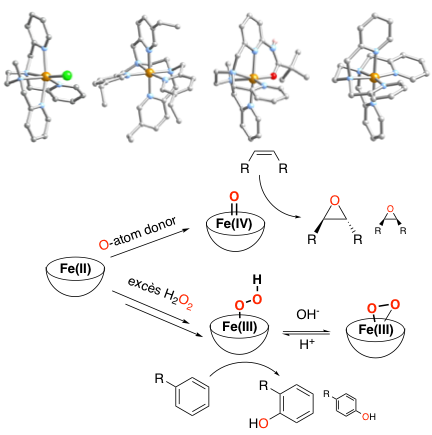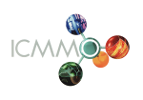Chimie Inorganique
Fe complexes, bioinspired catalysts for oxidation
Frédéric Banse (Prof), Jean-Noël Rebilly (Researcher), Katell Sénéchal-David (Associate Prof.)
Engineer : Flora Lefebvre
PhD student : Amanda Robinson
In chemical synthesis the conversion of small organic molecules into oxidized products with higher value added is most often carried out under stoichiometric and harsh conditions (high T and P, strong oxidizing agents generating harmful side products). In this context developping alternative solutions using molecular oxygen (cheap and environmentally innocuous) is highly desirable. However, due to its fundamental triplet (S=1) state the reaction of O2 with diamagnetic species is kinetically forbidden. Hence, its activation is required in order to overcome this limitation.
Interestingly, some metalloenzymes (monooxygenases, dioxygenases, hydroxylases) use O2 to catalyze the chemo-and regioselective oxidation of small organic substrates under mild conditions via the so-called "reductive activation of dioxygen". This corresponds to a controlled partial reduction of O2 at their active site which contains abundant bioavailable metal center(s) (Fe, Mn, Cu…). Therefore, reproducing the reactivity of these natural catalysts by means of simpler synthetic systems is relevant both from fundamental (determination of reaction mechanisms) and practical point of views (valorization of abundant feedstock).
Implementing cheap non heme FeII complexes and chemical oxidants, it is possible to generate Fe-peroxo, high valent Fe-oxo, that are able to oxidize small organic molecules. These reaction intermediates are reminiscent to those identified in the catalytic cycle of enzymes. Our main objectives are

1/ understanding the intrinsic reactivity of these species (Isolation and study of reaction intermediates);
2/ mimicking the reactivity of natural enzymes through the activation of small renewable molecules (O2, H2O) instead of chemical oxidants (Activation of small molecules);
3/ improving the reactivity of our synthetic catalysts with the help of supramolecular second coordination sphere interactions (Insertion of the complexes into supramolecular systems and second coordination sphere effects).
PhD theses
Ongoing
Amanda Robinson — New Fe complexes with a non-innocent second coordination sphrere for bio-inspired oxidation catalysis
PhD advisor : Frédéric Banse ; Co-advisor : Jean-Noël Rebilly (Started in october 2018)
Defended
Antoine Bohn — Electrochemical approach of the reductive activation of O2 by iron based molecular complexes (2018)
PhD advisor : Frédéric Banse ; Co-advisor : Katell Sénéchal-David
Charlotte Buron — Development of novel oxidation bioinspired catalysts : non heme iron(II) complexes grafted on golf electrode or β-lactoglobuline (2015)
PhD advisor : Frédéric Banse ; Co-advisor : Katell Sénéchal-David
Nathalie Segaud — Study of dioxygen activation by an iron(II) complex and new heterodinuclear complexes : Contributions for the development of bioinsipred oxidation catalysts (2013)
PhD advisor : Frédéric Banse ; Co-advisor : Katell Sénéchal-David
Last publications (2016 - Today)
Influence of a 2nd Sphere Hydrogen-Bond Donor on the Reactivity of Non-heme Fe(II) Complexes in Alkane, Alkene and Aromatic Oxidation with H2O2. A. L. Robinson, E. Bannerman, M. Di Berto Mancini, W. R. Browne, R. Guillot, C. Herrero, T. Inceoglu, H. Maisonneuve, F. Banse, J.-N. Rebilly, Chemistry – A European Journal, 2025, n/a, e202404668
Electrochemical approach of the reductive activation of O2 by a nonheme FeII complex. Some clues for the development of catalytic oxidations. A. Bohn, A. L. Robinson, K. Sénéchal-David, C. Herrero, F. Kanoufi, E. Anxolabéhère-Mallart, F. Banse, Dalton Trans., 2024, 53, 15491-15500
Modulation of intramolecular Fe oxidation with distance and driving force in Ru–Fe photocatalysts. C. Herrero, F. Banse, W. Leibl, A. Quaranta, New J. Chem., 2024, 48, 17027-17037
Assessment of new hydrogen peroxide activators in water and comparison of their active species toward contaminants of emerging concern. G. Farinelli, J.-N. Rebilly, F. Banse, M. Cretin, D. Quemener, Scientific Reports, 2024, 14, 9301
Significant effect of 2nd sphere interactions on the reductive activation of O2 by non-heme iron(II) complexes. Application to the electroassisted oxidation of thioanisole. A. L. Robinson, E. Bannermann, R. Guillot, C. Herrero, K. Sénéchal-David, E. Rivière, F. Banse, J.-N. Rebilly, European Journal of Inorganic Chemistry, 2024, 27, e202300694
Beneficial Effect of Acetic Acid on the Formation of FeIII(OOH) Species and on the Catalytic Activity of Bioinspired Nonheme FeII Complexes. R. Bercy, J.-N. Rebilly, C. Herrero, R. Guillot, H. Maisonneuve, F. Banse, European Journal of Inorganic Chemistry, 2023, 26, e202300236
Disproportionation of H2O2 to Dioxygen on a Nonheme Iron Center. A Computational Study. H. P. H. Wong, F. Banse, S. P. De Visser, ChemCatChem, 2023, n/a, e202300957
Iron ions embedded in hexagonal mesoporous silica via a simple method: implementation in mild oxidation catalysis. R. Guemati, J.-N. Rebilly, G. Fornasieri, D. Dragoe, S. Biswas, F. Banse, A. Bleuzen, ChemistrySelect, 2023, 8, e202302150
Revitalizing Inert Materials: Grafting Self‐Oscillating, Stimuli‐Responsive Organometallic Polymers for Pulsating Systems. J. Pirkin‐benameur, V. Bouad, F. Lefèbvre, D. Bouyer, K. Sénéchal‐david, J.-N. Rebilly, F. Banse, D. Fournier, P. Woisel, J. Lyskawa, Advanced Materials Interfaces, 2023, 2300346
Catalytic oxidation properties of an acid-resistant cross-bridged cyclen Fe(ii) complex. Influence of the rigid donor backbone and protonation on the reactivity. J.-N. Rebilly, C. Herrero, K. Sénéchal-David, R. Guillot, F. Banse, Dalton Trans., 2023, 52, 9017-9025
Heterolytic O− O bond cleavage upon single electron transfer to a nonheme Fe (III)− OOH complex. A. Bohn, K. Sénéchal‐david, J.-N. Rebilly, C. Herrero, W. Leibl, E. Anxolabéhère‐mallart, F. Banse, Chemistry–A European Journal, 2022, 28, e202201600
Photocatalytic generation of a non-heme Fe(iii)-hydroperoxo species with O2 in water for the oxygen atom transfer reaction. E. Pugliese, N. T. Vo, A. Boussac, F. Banse, Y. Mekmouche, J. Simaan, T. Tron, P. Gotico, M. Sircoglou, Z. Halime, W. Leibl, A. Aukauloo, Chem. Sci., 2022, 13, 12332-12339
A tale of two complexes: electro-assisted oxidation of thioanisole by a “O2 activator / oxidizing species” tandem system of non-heme iron complexes. A. L. Robinson, J.-N. Rebilly, R. Guillot, C. Herrero, H. Maisonneuve, F. Banse, Chemistry – A European Journal, 2022, 28, e202200217
Second-sphere effects on H2O2 activation by non-heme FeII complexes: role of a phenol group in the [H2O2]-dependent accumulation of FeIVO vs. FeIIIOOH. J.-N. Rebilly, C. Herrero, K. Sénéchal-David, R. Guillot, T. Inceoglu, H. Maisonneuve, F. Banse, Chem. Sci., 2021, 12, 15691-15699
Tracking light-induced electron transfer toward O2 in a hybrid photoredox-laccase system. R. Farran, Y. Mekmouche, N. T. Vo, C. Herrero, A. Quaranta, M. Sircoglou, F. Banse, P. Rousselot-Pailley, A. J. Simaan, A. Aukauloo, T. Tron, W. Leibl, iScience, 2021, 24, 102378
Modulating alkene reactivity from oxygenation to halogenation via electrochemical O2 activation by Mn porphyrin. N. Kostopoulos, F. Banse, C. Fave, E. Anxolabéhère-Mallart, Chem. Commun., 2021, 57, 1198-1201
Sequential installation of Fe(ii) complexes in MOFs: towards the design of solvatochromic porous solids. F. Moreau, J. Marrot, F. Banse, C. Serre, A. Tissot, J. Mater. Chem. C, 2020, 8, 16826-16833
Directing the solid-state photochromic and luminescent behaviors of spiromolecules with Dawson and Anderson polyoxometalate units. H. Dridi, A. Boulmier, P. Bolle, A. Dolbecq, J.-N. Rebilly, F. Banse, L. Ruhlmann, H. Serier-Brault, R. Dessapt, P. Mialane, O. Oms, J. Mater. Chem. C, 2020, 8, 637-649
Non-Symmetrical Sterically Challenged Phenanthroline Ligands and Their Homoleptic Copper(I) Complexes with Improved Excited-State Properties. L. Gimeno, E. Blart, J.-N. Rebilly, M. Coupeau, M. Allain, T. Roisnel, A. Quarré De Verneuil, C. Gourlaouen, C. Daniel, Y. Pellegrin, Chemistry – A European Journal, 2020, 26, 11887-11899
Playing with Magnetic Anisotropy in Hexacoordinated Mononuclear Ni(II) Complexes, An Interplay Between Symmetry and Geometry. N. Suaud, G. Rogez, J.-N. Rebilly, M.-A. Bouammali, N. Guihéry, A.-L. Barra, T. Mallah, Applied Magnetic Resonance, 2020, 59, 13341-13346
FeIII and FeII Phosphasalen Complexes: Synthesis, Characterization, and Catalytic Application for 2-Naphtol Oxidative Coupling. E. Oheix, C. Herrero, J. Moutet, J.-N. Rebilly, M. Cordier, R. Guillot, S. Bourcier, F. Banse, K. Sénéchal-David, A. Auffrant, Chemistry – A European Journal, 2020, 26, 13634-13643
Hydroxylation of Aromatics by H2O2 Catalyzed by Mononuclear Non-heme Iron Complexes: Role of Triazole Hemilability in Substrate-Induced Bifurcation of the H2O2 Activation Mechanism. J.-N. Rebilly, W. Zhang, C. Herrero, H. Dridi, K. Sénéchal-David, R. Guillot, F. Banse, Chemistry – A European Journal, 2020, 26, 659-668
Base-controlled mechanistic divergence between iron(iv)-oxo and iron(iii)-hydroperoxo in the H2O2 activation by a nonheme iron(ii) complex. A. Bohn, C. Chinaux-Chaix, K. Cheaib, R. Guillot, C. Herrero, K. Sénéchal-David, J.-N. Rebilly, F. Banse, Dalton Trans., 2019, 48, 17045-17051
A Reversible Electron Relay to Exclude Sacrificial Electron Donors in the Photocatalytic Oxygen Atom Transfer Reaction with O2 in Water. N. T. Vo, Y. Mekmouche, T. Tron, R. Guillot, F. Banse, Z. Halime, M. Sircoglou, W. Leibl, A. Aukauloo, Angewandte Chemie International Edition, 2019, 58, 16023-16027
Non-heme FeII diastereomeric complexes bearing a hexadentate ligand : unexpected consequences on the spin state and oxidation catalytic properties. K. Sénéchal-David, C. Buron, N. Ségaud, J.-N. Rebilly, A. Dos Santos, J. Farjon, R. Guillot, C. Herrero, T. Inceoglu, F. Banse, Chem. Eur. J., 2019, 25, 12405 – 12411
Bioinspired molecular catalysts for homogenous electrochemical activation of dioxygen. E. Anxolabéhère-Mallart, F. Banse, Current Opinion in Electrochemistry, 2019, 15, 118-124
Selective Formation of an FeIVO or an FeIIIOOH Intermediate From Iron(II) and H2O2 : Controlled Heterolytic versus Homolytic Oxygen-Oxygen Bond Cleavage by the Second Coordination Sphere. K. Cheaib, M. Q. E. Mubarak, K. Sénéchal-David, C. Herrero, R. Guillot, M. Clémancey, J.-M. Latour, S. D. Visser, J.-P. Mahy, F. Banse, F. Avenier, Angew. Chem. Int. Ed., 2019, 58, 854-858
Chemoselective guest-triggered shaping of a polynuclear CuII calix[6]complex into a molecular host. S. Richard, G. Le Duc, N. Le Poul, Y. Le Mest, O. Reinaud, J.-N. Rebilly, Dalton Trans., 2017, 46, 15249-15256
Imidazolidine Ring Cleavage upon Complexation with First Row Transition Metals. K. Cheaib, C. Herrero, R. Guillot, F. Banse, J.-P. Mahy, F. Avenier, Eur. J. Inorg. Chem., 2017, 3884-3891
Synthesis and characterization of FeII complexes with a BPMEN type ligand bearing π-accepting nitro groups. A. Bohn, K. Sénéchal-David, J. Vanoutryve, R. Guillot, E. Rivière, F. Banse, European Journal of Inorganic Chemistry, 2017, 3057-3063
Mimicking the Regulation Step of Fe-Monooxygenases: Allosteric Modulation of FeIV-Oxo Formation by Guest Binding in a Dinuclear ZnII–FeII Calix[6]arene-Based Funnel Complex. N. Ségaud, C. De thomasson, C. Daverat, K. Sénéchal-David, A. Dos Santos, V. Steinmetz, P. Maître, J.-N. Rebilly, F. Banse, O. Reinaud, Chemistry – A European Journal, 2017, 23, 2894-2906
Characterization and Subsequent Reactivity of an Fe-Peroxo Porphyrin Generated by Electrochemical Reductive Activation of O2. R. Oliveira, W. Zouari, C. Herrero, F. Banse, B. Schöllhorn, C. Fave, E. Anxolabéhère-Mallart, Inorg. Chem., 2016, 55, 12204-12210
Photoassisted Oxidation of Sulfides Catalyzed by Artificial Metalloenzymes Using Water as an Oxygen Source. C. Herrero, N. Nguyen-Thi, F. Hammerer, F. Banse, D. Gagné, N. Doucet, J.-P. Mahy, R. Ricoux, Catalysts, 2016, 6, 202
Self-assembled monolayer formation of a (N5)Fe(ii) complex on gold electrodes: electrochemical properties and coordination chemistry on a surface. C. Buron, S. Groni, N. Segaud, S. Mazerat, D. Dragoe, C. Fave, K. Senechal-David, B. Schollhorn, F. Banse, Dalton Trans., 2016, 45, 19053-19061
Arene activation by a nonheme iron(III)–hydroperoxo complex: pathways leading to phenol and ketone products. A. S. Faponle, F. Banse, S. P. De Visser, JBIC Journal of Biological Inorganic Chemistry, 2016, 21, 453-462
Oxidation catalysis via visible-light water activation of a [Ru(bpy)3]2+ chromophore BSA-metallocorrole couple. C. Herrero, A. Quaranta, R. Ricoux, A. Trehoux, A. Mahammed, Z. Gross, F. Banse, J.-P. Mahy, Dalton Trans., 2016, 45, 706-710
Last update on Feb. 28th 2022

